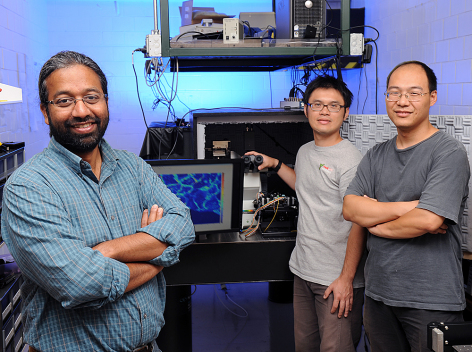

| Visitors Now: | |
| Total Visits: | |
| Total Stories: |

| Story Views | |
| Now: | |
| Last Hour: | |
| Last 24 Hours: | |
| Total: | |
New Tool Invented To Study Single Biological Molecules

Photo by Bob Elbert.
By blending optical and atomic force microscope technologies, Iowa State University and Ames Laboratory researchers have found a way to complete 3-D measurements of single biological molecules with unprecedented accuracy and precision.
Existing technologies allow researchers to measure single molecules on the x and y axes of a 2-D plane. The new technology allows researchers to make height measurements (the z axis) down to the nanometer – just a billionth of a meter – without custom optics or special surfaces for the samples.
“This is a completely new type of measurement that can be used to determine the z position of molecules,” said Sanjeevi Sivasankar, an Iowa State assistant professor ofphysics and astronomy and an associate of the U.S. Department of Energy’s Ames Laboratory.
Details of the technology were recently published by the journal Nano Letters. Co-authors of the study are Sivasankar; Hui Li, an Iowa State post-doctoral research associate in physics and astronomy and an associate of the Ames Laboratory; and Chi-Fu Yen, an Iowa State doctoral student in electrical and computer engineering and a student associate of the Ames Laboratory.
The project was supported by lab startup funds from Iowa State University and a $120,075 grant from the Grow Iowa Values Fund, a state economic development program.
Sivasankar’s research program has two objectives: to learn how biological cells adhere to each other and to develop new tools to study those cells.
That’s why the new microscope technology – called standing wave axial nanometry (SWAN) – was developed in Sivasankar’s lab.
Here’s how the technology works: Researchers attach a commercial atomic force microscope to a single molecule fluorescence microscope. The tip of the atomic force microscope is positioned over a focused laser beam, creating a standing wave pattern. A molecule that has been treated to emit light is placed within the standing wave. As the tip of the atomic force microscope moves up and down, the fluorescence emitted by the molecule fluctuates in a way that corresponds to its distance from the surface. That distance can be compared to a marker on the surface and measured.
“We can detect the height of the molecule with nanometer accuracy and precision,” Sivasankar said.
The paper reports that measurements of a molecule’s height are accurate to less than a nanometer. It also reports that measurements can be taken again and again to a precision of 3.7 nanometers.
Sivasankar’s research team used fluorescent nanospheres and single strands of DNA to calibrate, test and prove their new instrument.
Users who could benefit from the technology include medical researchers who need high-resolution data from microscopes. Sivasankar thinks the technology has commercial potential and is confident it will advance his own work in single molecule biophysics.
“We hope to use this technology to move that research forward,” he said. “And in doing that, we’ll continue to invent new technologies.”
Contacts and sources:
Sanjeevi Sivasankar
Iowa State University
2012-08-05 01:00:56
Source: http://nanopatentsandinnovations.blogspot.com/2012/08/new-tool-invented-to-study-single.html
Source:


